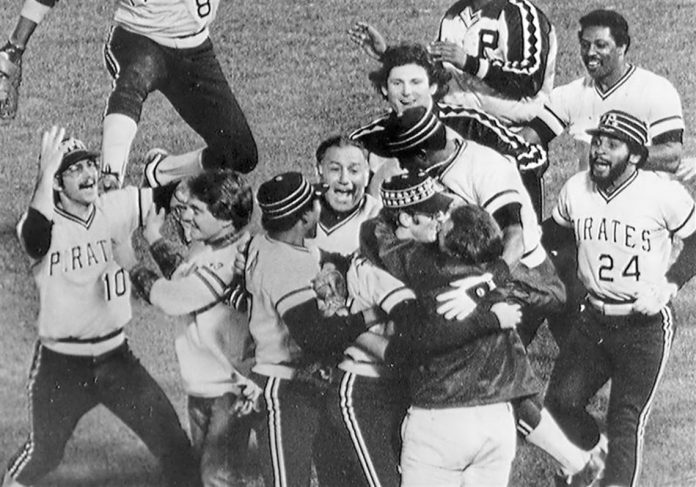As I mentioned yesterday, the Pirates had two big guns on offense in Willie Stargell and Dave Parker, but the lineup in 1978 lacked depth. Offense up the middle looked like a potential problem going into 1979.
The returning regular behind the plate was Ed Ott, a roughly average hitter and capable defender who typically put up a CS% around average. A left-handed hitter, Ott seldom faced LHPs during his career and, not surprisingly, didn’t hit much against them. He’d have a new platoon mate in ’79, with rookie Steve Nicosia replacing free agent Duffy Dyer. The 23-year-old Nicosia had only six plate appearances in the majors prior to ’79, but he’d put up a .922 OPS in AAA in ’78. Like Ott, he proved to be a competent defender.
Also on hand was Manny Sanguillen, rescued at the beginning of the ’78 season from a one-year exile in Oakland, where he’d gone in exchange for manager Chuck Tanner. With his knees largely shot, Sangy had gone downhill quickly. He seldom caught in ’78, mostly appearing as a platoon first baseman and pinch hitter. In ’79 he mostly served as a pinch hitter.
The infield corners were manned by Willie Stargell and Phil Garner. Pops’ playing time was increasingly limited, but he was still a formidable power hitter. In ’78, he posted a 295/382/567 line (in a much less offense-oriented era), with 28 dingers and 97 RBIs, despite playing only about two thirds of the time.
Garner came to the Pirates in a nine-player trade with Oakland prior to the ’77 season. The Pirates gave up a lot, sending out Tony Armas, Mitchell Page, Doug Bair, Rick Langford, mega-disappointment Doc Medich, and fading relief ace Dave Giusti. (The Pirates traded Garner to the Astros in 1981 for Johnny Ray.) A natural second baseman, Garner moved to third for the Pirates in deference to Rennie Stennett. He’d been a slightly above-average hitter with solid all-around skills.
The middle infield looked more iffy. Stennett seemed to be establishing himself as a star in 1977, playing outstanding defense at second and batting .336. A couple years previously he’d had the 20th century’s only seven-hit game. His ’77 season ended in August, though, with a broken right leg. He was never the same after that, posting just a 60 OPS+ in ’78. At short the Pirates had five-year starter Frank Taveras, a below-average hitter and increasingly erratic defender with excellent speed. He’d led the majors in steals with 70 back in 1977, but in ’78 he led everybody in getting caught stealing. The primary infield backup — in fact, the only one who played much — was Dale Berra, son of Yogi. He was a good hitter in the minors, but it never came together for him in the majors. Still only 22, he’d gotten into 56 games with the Bucs in ’78.
The outfield, as usual, figured to be a strong point, mainly due to right fielder Dave Parker. The reigning MVP, Parker was coming off his career-best season, batting 334/394/585 in 1978, with 30 home runs and 117 RBIs. Also known for one of baseball’s best outfield arms, Parker could be error-prone in the field, not surprisingly with his 6’5″ frame.
Center and left featured Omar Moreno and Bill Robinson. The very speedy Moreno was a type of player not much favored these days, as he was just a so-so hitter with little power who seldom walked. (The ’78 season had been an exception for him, with 81 free passes.) Moreno added a lot of value on the bases despite high CS totals, and covered a lot of ground in center, although he could be erratic there. He’d led the majors in steals with 71 in 1978 and went on to total 487 in his career. Robinson was a late-bloomer, finally establishing himself at age 32 with the Pirates in 1975. He generally hit for average and power, although he almost never walked. Robinson sometimes spelled Stargell at first, and now and then played third. He needed to bounce back from a weak ’78 season in which he’d batted just 246/296/411.
The Pirates had a lot of outfield depth, with Lee Lacy, John Milner and Mike Easler. Lacy had just signed with them as a free agent and could also play second. Milner had come from Texas in a massive, four-team trade after the ’77 season (more on that tomorrow). Like Robinson, he could also play first and was coming off something of a down season. Easler was a long-time AAA slugger who finally got established in 1980; for the time being, he was mainly a pinch hitter.
Finally, the Pirates opened the season with a very Tanner-like gadget player in Matt Alexander. He ultimately managed a nine-year career almost exclusively as a pinch runner. He finished his career with 103 steals and only 195 plate appearances.
Tomorrow, the pitching.



